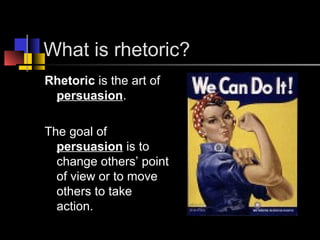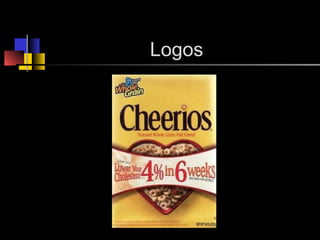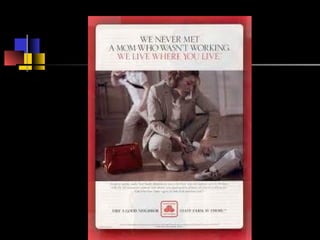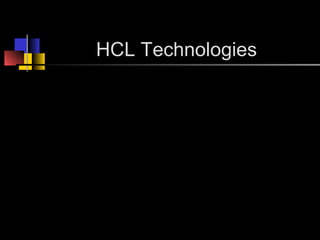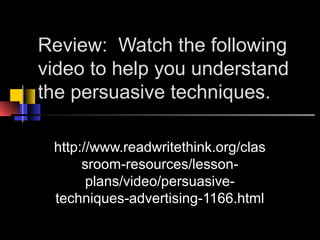Ethos.pathos.logos 2
- 1. Aristotle’s Ways to Persuade Logos Ethos Pathos Kairos March 14, 2016 Mr. E. Ortiz
- 2. Who is Aristotle? Aristotle (384-322 BCE) is the most notable product of the educational program devised by Plato. Aristotle wrote on an amazing range of subjects, from logic, philosophy, and ethics to physics, biology, psychology, politics, and rhetoric.
- 3. What is rhetoric? Rhetoric is the art of persuasion. The goal of persuasion is to change others’ point of view or to move others to take action.
- 4. What is logos, ethos, and pathos, & kairos? Logos = Logic Ethos = Ethics, Image Pathos = Emotions (Passion) Kairos= Urgency
- 5. Logos Logos is an argument based on facts, evidence and reason. Using logos means appealing to the readers’ sense of what is logical. The logos of an ad is straightforward. It tells you exactly what the product does, how it works, and/or what it is used for. Much more useful in print or online ads due to time constraints. Examples: facts, numbers, experts, money, percents
- 6. Logos
- 7. Ethos Ethos is an argument based on character. Using ethos means the writer or speaker appeals to the audience’s sense of ethical behavior. The writer, speaker, or product presents himself as credible, trustworthy, honest and/or ethical. Examples: testimonies, patriotic images, trust speeches, seals of approval, warranty, guarantees
- 8. Ethos
- 9. Pathos Pathos = argument based on feelings Using pathos means appealing to readers’ emotions and feelings. Examples: guilt (puppy eyes, swelling music), pride (flags), fear (baby, family)
- 10. Pathos
- 11. Kairos Argument based on a sense of urgency. Examples: Limited Time Offer, Coupons, Expiration Dates, Bonus Offers
- 12. Kairos
- 13. What kinds of persuasion can you find in each of the following ads?
- 26. milk
- 27. bank
- 28. HCL Technologies
- 29. Jordan
- 30. Computer
- 31. Review Movie
- 33. Logos Example In the following example, note how Ian Ayres uses evidence from experience (her work environment, Delta Airlines, the University of Chicago). This evidence establishes the precedent that Ayres uses to compare to the current situation that she argues should be changed.
- 34. Ethos Example In the following example, note how Nancy Mairs establishes her credibility and trustworthiness and authority to write about this subject by being honest. Mairs admits she is uncertain about her own motives and shows she understands the discomfort others’ have with this subject.
- 35. Ethos Examples People—crippled or not—wince at the word “cripple,” as they do not at “handicapped” or “disabled.” Perhaps I want them to wince. I want them to see me as a tough customer, one to whom the fates/gods/viruses have not been kind, but who can face the brutal truth of her existence squarely. As a cripple, I swagger. —Nancy Mairs, “On Being a Cripple”
- 36. Pathos Example In the following example from a speech by Winston Churchill, note the use of anaphora (repetition of a word or group of words at the beginning of items in a series). This repetition emphasizes the point and expresses passion and emotion. Moreover, the repetition affects the audience emotionally.
- 37. Logos Example We don’t have single-sex toilets at home, and we don’t need them at the office. Then there’s also the small question of efficiency. I see my male colleagues waiting in line to use the men’s room, when the women’s toilet is unoccupied. Which is precisely why Delta Airlines doesn’t label those two bathrooms at the back of the plane as being solely for men and women. It just wouldn’t fly.
- 38. Review: Watch the following video to help you understand the persuasive techniques. http://www.readwritethink.org/clas sroom-resources/lesson- plans/video/persuasive- techniques-advertising-1166.html
- 39. Watch the tv ads at each of the following sites. Fill out the handout. http://www.goodbysilverstein.com/#/work/g ot_milk_tv_dentist_broadcast http://www.goodbysilverstein.com/# http://www.wk.com/campaign/the_employe es_first_effect http://www.wk.com/campaign/the_name
- 40. Pathos Example We shall not flag or fail. We shall go on to the end. We shall fight in France, we shall fight on the seas and oceans, we shall fight with growing confidence and growing strength in the air, we shall defend our island, whatever the cost may be, we shall fight on the beaches, we shall fight on the landing grounds, we shall fight in the fields and in the streets, we shall fight in the hills. We shall never surrender. —Winston Churchill, speech to the House of Commons, June 4, 1940
- 41. Review Logos = logic Logos is an argument based on facts, evidence and reason. Using logos means appealing to the readers’ sense of what is logical.
- 42. Review Ethos = Ethics / Image Ethos is an argument based on character. The writer or speaker presents him or herself to the reader as credible, trustworthy, honest and ethical.
- 43. Review Pathos = argument based on feelings Using pathos means appealing to readers’ emotions and feelings.


